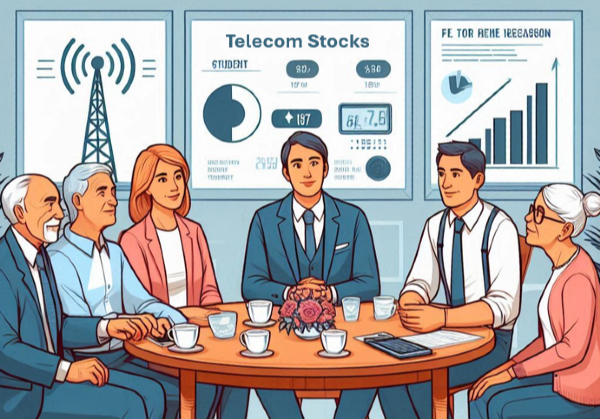What is the Telecom Sector?
The telecommunications industry encompasses companies that make communication possible on a global scale, whether through phone, internet, airwaves, cables, or wires. This sector includes a wide range of businesses, from traditional telephone companies to mobile network operators, internet service providers, and satellite communication firms. The telecom industry is the backbone of modern communication, enabling the exchange of information across vast distances and playing a crucial role in the functioning of economies and societies worldwide.
In recent years, the telecom industry has been at the forefront of technological advancements, particularly with the rollout of 5G networks. These next-generation networks promise faster speeds, lower latency, and the ability to connect a vast number of devices simultaneously, paving the way for innovations such as the Internet of Things (IoT), smart cities, and autonomous vehicles. As the demand for seamless and reliable communication continues to grow, the telecom industry remains a dynamic and essential part of the global infrastructure, driving progress and connecting people and businesses like never before.
Read More: The Top Telecom Stocks
What do telecom companies do?
Telecom companies are responsible for providing communication services to individuals, businesses, and governments. These services include voice, data, and video transmission through various means such as wired, wireless, and satellite networks. For instance, AT&T and Verizon are major telecom operators in the United States that offer mobile phone services, internet connectivity, and television broadcasting. They maintain extensive infrastructure, including cell towers, fiber-optic cables, and data centers, to ensure seamless communication across vast distances.
In addition to network operators, telecom companies also include equipment providers like Ericsson, Nokia, and Huawei. These companies design and manufacture the hardware and software necessary for building and maintaining telecom networks. For example, Ericsson supplies radio access network (RAN) equipment that enables wireless communication, while Nokia provides core network solutions that manage data traffic and ensure network security. Huawei, on the other hand, offers a comprehensive range of telecom equipment, including routers, switches, and base stations, which are essential for network deployment and operation.
Telecom companies also play a crucial role in advancing technology and innovation. They invest heavily in research and development to improve network performance, increase data speeds, and enhance user experience. For example, companies like Qualcomm and Intel are at the forefront of developing 5G technology, which promises faster internet speeds, lower latency, and greater connectivity for devices. These advancements enable new applications such as autonomous vehicles, smart cities, and the Internet of Things (IoT), transforming how we live and work.

Moreover, telecom companies are involved in various business services, including cloud computing, cybersecurity, and managed services. Companies like IBM and Cisco offer cloud solutions that allow businesses to store and access data remotely, while also providing cybersecurity services to protect against cyber threats. Managed services, offered by companies like Accenture and TCS, involve outsourcing IT and network management to telecom providers, allowing businesses to focus on their core operations. These services are essential for modern enterprises, ensuring reliable communication, data security, and efficient IT management.
Read More: What is the Future of the Telecom Industry?
What is the difference between the Technology and Telecom industry?
Telecom Stocks:
Telecom stocks represent companies that provide communication services, such as telephone, internet, and television services. Examples include AT&T, Verizon, and T-Mobile. Telecom companies primarily generate revenue through subscription-based services, including voice, data, and video services.
The growth in telecom stocks is often driven by the expansion of network infrastructure, such as 5G, and increasing demand for data services.
These stocks are often considered stable and income-generating investments due to their consistent cash flow from subscription services. They may offer attractive dividends but typically have slower growth compared to tech stocks.
Technology Stocks:
Technology stocks represent companies involved in the development and manufacturing of technology products or services. This includes software, hardware, semiconductors, and internet services. Examples include Apple, Microsoft, and Google. Tech companies generate revenue through various models, including product sales, software licensing, advertising, and subscription services.
These stocks are known for their high growth potential, driven by innovation, new product development, and expanding market opportunities and are often considered growth investments. They may offer significant capital appreciation but can be more volatile and may not provide regular dividends.
Decision to Separate the Sectors
The decision to separate telecom and technology sectors was primarily driven by the need to provide clearer categorization and better reflect the distinct nature of these industries. This separation helps investors, analysts, and regulators to better understand and evaluate the performance and potential of companies within each sector.
Telecom and technology companies operate under different business models. Telecom companies focus on providing communication services, while technology companies are involved in innovation and product development. Separating the sectors allows for more accurate analysis and comparison within each industry.
Read More: The Best Telecom Dividend Stocks for a Steady Income Stream
Investors often have different strategies and expectations for telecom and technology stocks. Telecom stocks are typically seen as stable, income-generating investments, while technology stocks are viewed as high-growth opportunities. Separating the sectors allows investors to tailor their portfolios according to their risk tolerance and investment goals.
The market dynamics and competitive landscapes of the telecom and technology sectors are distinct. Telecom companies compete based on network coverage and service quality, while technology companies compete on innovation and product features. Separation helps in better understanding and analyzing these dynamics.
What is included in the telecommunications sector?

The telecommunications industry encompasses a wide range of businesses, including telephone operators, internet service providers (ISPs), cable companies, satellite companies, telecom equipment manufacturers, managed services providers, content providers, regulatory bodies, and consulting firms. Telephone operators offer both wired and wireless services, with major players like AT&T and Verizon leading the market. ISPs provide high-speed internet access through various technologies such as DSL, cable, fiber-optic, and satellite. Cable companies, like Comcast and Charter Communications, offer television services and bundled packages that include internet and telephone services. Satellite companies provide TV and internet services, especially in remote areas. Telecom equipment manufacturers, such as Cisco and Nokia, produce essential network infrastructure and consumer devices.
Managed services providers ensure network reliability and security, while content providers like Netflix and Amazon Prime deliver streaming services over telecom networks. Content delivery networks (CDNs) optimize the delivery of online content. Regulatory bodies, such as the Federal Communications Commission (FCC) in the U.S., oversee the industry to ensure fair competition and consumer protection. Consulting firms like Deloitte and Accenture offer strategic advice and technical expertise to telecom companies. The telecommunications industry is constantly evolving, driven by technological advancements and changing consumer demands, playing a crucial role in maintaining seamless communication and connectivity in our digital world.
What are the different types of telecom companies?
Telecom companies can be broadly categorized into three main types: wireless carriers, wireline carriers, and cable operators. Wireless carriers provide mobile communication services, including voice, text, and data, through cellular networks. Major players in this category include companies like Verizon, AT&T, and T-Mobile. These companies invest heavily in infrastructure to support the latest technologies, such as 5G, to offer faster and more reliable services to their customers. Wireline carriers, on the other hand, offer traditional landline telephone services, as well as broadband internet and television services through fixed-line networks. Examples of wireline carriers include companies like CenturyLink and Frontier Communications.
Cable operators primarily provide television services but have expanded their offerings to include high-speed internet and voice services. Companies like Comcast and Charter Communications fall into this category. These operators use coaxial or fiber-optic cables to deliver their services, often bundling them into attractive packages for consumers. Additionally, there are satellite providers like Dish Network and DirecTV, which offer television and internet services via satellite technology. Each type of telecom company plays a crucial role in the overall telecommunications ecosystem, catering to different consumer needs and preferences.
The Telecom Value Chain

The telecom value chain comprises a series of interconnected activities essential for delivering telecommunications services. It begins with network planning and design, where companies strategize the layout and capacity of their networks to meet current and future demands. This is followed by infrastructure deployment, which involves the installation of physical components like fiber-optic cables, cell towers, and data centers. Next, network operations and maintenance ensure the network runs smoothly and efficiently, addressing any issues that arise.
The value chain continues with service provisioning, where telecom companies offer various services such as voice, data, and video to consumers and businesses. Customer support and billing are also crucial, as they handle customer inquiries, technical support, and billing processes. Finally, content and application delivery involves providing additional services like streaming, cloud computing, and IoT solutions. By optimizing each step of the value chain, telecom companies can enhance their service quality and create value for their customers.
Read More: Is it Good to Invest in Telecommunication Stocks?
Conclusion
In conclusion, the telecom sector is a vital component of global communication, driving technological advancements and enabling seamless connectivity. With the ongoing rollout of 5G networks, the industry is poised for significant growth, offering faster speeds, lower latency, and enhanced connectivity. Telecom companies, from network operators to equipment providers, play a crucial role in advancing technology and innovation, ensuring reliable communication services for individuals, businesses, and governments. As the demand for efficient and secure communication continues to rise, the telecom industry remains a dynamic and essential part of the global infrastructure, connecting people and businesses like never before.






























What is the Telecom Sector?
Image by Markus Winkler from Pixabay
The telecommunications industry encompasses companies that make communication possible on a global scale, whether through phone, internet, airwaves, cables, or wires. This sector includes a wide range of businesses, from traditional telephone companies to mobile network operators, internet service providers, and satellite communication firms. The telecom industry is the backbone of modern communication, enabling the exchange of information across vast distances and playing a crucial role in the functioning of economies and societies worldwide. In recent years, the telecom industry has been at the forefront of technological advancements, particularly with the rollout of 5G networks. These next-generation networks promise faster speeds, lower latency, and the ability to connect a vast number of devices simultaneously, paving the way for innovations such as the Internet of Things (IoT), smart cities, and autonomous vehicles. As the demand for seamless and reliable communication continues to grow, the telecom industry remains a dynamic and essential part of the global infrastructure, driving progress and connecting people and businesses like never before.
What do telecom companies do?
Telecom companies are responsible for providing communication services to individuals, businesses, and governments. These services include voice, data, and video transmission through various means such as wired, wireless, and satellite networks. For instance, AT&T and Verizon are major telecom operators in the United States that offer mobile phone services, internet connectivity, and television broadcasting. They maintain extensive infrastructure, including cell towers, fiber-optic cables, and data centers, to ensure seamless communication across vast distances. In addition to network operators, telecom companies also include equipment providers like Ericsson, Nokia, and Huawei. These companies design and manufacture the hardware and software necessary for building and maintaining telecom networks. For example, Ericsson supplies radio access network (RAN) equipment that enables wireless communication, while Nokia provides core network solutions that manage data traffic and ensure network security. Huawei, on the other hand, offers a comprehensive range of telecom equipment, including routers, switches, and base stations, which are essential for network deployment and operation. Telecom companies also play a crucial role in advancing technology and innovation. They invest heavily in research and development to improve network performance, increase data speeds, and enhance user experience. For example, companies like Qualcomm and Intel are at the forefront of developing 5G technology, which promises faster internet speeds, lower latency, and greater connectivity for devices. These advancements enable new applications such as autonomous vehicles, smart cities, and the Internet of Things (IoT), transforming how we live and work.
Image by Gerd Altmann from Pixabay
Moreover, telecom companies are involved in various business services, including cloud computing, cybersecurity, and managed services. Companies like IBM and Cisco offer cloud solutions that allow businesses to store and access data remotely, while also providing cybersecurity services to protect against cyber threats. Managed services, offered by companies like Accenture and TCS, involve outsourcing IT and network management to telecom providers, allowing businesses to focus on their core operations. These services are essential for modern enterprises, ensuring reliable communication, data security, and efficient IT management.
What is the difference between the Technology and Telecom industry?
Telecom Stocks:
Telecom stocks represent companies that provide communication services, such as telephone, internet, and television services. Examples include AT&T, Verizon, and T-Mobile. Telecom companies primarily generate revenue through subscription-based services, including voice, data, and video services.
The growth in telecom stocks is often driven by the expansion of network infrastructure, such as 5G, and increasing demand for data services.
These stocks are often considered stable and income-generating investments due to their consistent cash flow from subscription services. They may offer attractive dividends but typically have slower growth compared to tech stocks.
Technology Stocks:
Technology stocks represent companies involved in the development and manufacturing of technology products or services. This includes software, hardware, semiconductors, and internet services. Examples include Apple, Microsoft, and Google. Tech companies generate revenue through various models, including product sales, software licensing, advertising, and subscription services.
These stocks are known for their high growth potential, driven by innovation, new product development, and expanding market opportunities and are often considered growth investments. They may offer significant capital appreciation but can be more volatile and may not provide regular dividends.
Decision to Separate the Sectors
The decision to separate telecom and technology sectors was primarily driven by the need to provide clearer categorization and better reflect the distinct nature of these industries. This separation helps investors, analysts, and regulators to better understand and evaluate the performance and potential of companies within each sector.
Telecom and technology companies operate under different business models. Telecom companies focus on providing communication services, while technology companies are involved in innovation and product development. Separating the sectors allows for more accurate analysis and comparison within each industry.
Investors often have different strategies and expectations for telecom and technology stocks. Telecom stocks are typically seen as stable, income-generating investments, while technology stocks are viewed as high-growth opportunities. Separating the sectors allows investors to tailor their portfolios according to their risk tolerance and investment goals.
The market dynamics and competitive landscapes of the telecom and technology sectors are distinct. Telecom companies compete based on network coverage and service quality, while technology companies compete on innovation and product features. Separation helps in better understanding and analyzing these dynamics.
What is included in the telecommunications sector?
Image by brunowollet from Pixabay
The telecommunications industry encompasses a wide range of businesses, including telephone operators, internet service providers (ISPs), cable companies, satellite companies, telecom equipment manufacturers, managed services providers, content providers, regulatory bodies, and consulting firms. Telephone operators offer both wired and wireless services, with major players like AT&T and Verizon leading the market. ISPs provide high-speed internet access through various technologies such as DSL, cable, fiber-optic, and satellite. Cable companies, like Comcast and Charter Communications, offer television services and bundled packages that include internet and telephone services. Satellite companies provide TV and internet services, especially in remote areas. Telecom equipment manufacturers, such as Cisco and Nokia, produce essential network infrastructure and consumer devices. Managed services providers ensure network reliability and security, while content providers like Netflix and Amazon Prime deliver streaming services over telecom networks. Content delivery networks (CDNs) optimize the delivery of online content. Regulatory bodies, such as the Federal Communications Commission (FCC) in the U.S., oversee the industry to ensure fair competition and consumer protection. Consulting firms like Deloitte and Accenture offer strategic advice and technical expertise to telecom companies. The telecommunications industry is constantly evolving, driven by technological advancements and changing consumer demands, playing a crucial role in maintaining seamless communication and connectivity in our digital world.
What are the different types of telecom companies?
Telecom companies can be broadly categorized into three main types: wireless carriers, wireline carriers, and cable operators. Wireless carriers provide mobile communication services, including voice, text, and data, through cellular networks. Major players in this category include companies like Verizon, AT&T, and T-Mobile. These companies invest heavily in infrastructure to support the latest technologies, such as 5G, to offer faster and more reliable services to their customers. Wireline carriers, on the other hand, offer traditional landline telephone services, as well as broadband internet and television services through fixed-line networks. Examples of wireline carriers include companies like CenturyLink and Frontier Communications. Cable operators primarily provide television services but have expanded their offerings to include high-speed internet and voice services. Companies like Comcast and Charter Communications fall into this category. These operators use coaxial or fiber-optic cables to deliver their services, often bundling them into attractive packages for consumers. Additionally, there are satellite providers like Dish Network and DirecTV, which offer television and internet services via satellite technology. Each type of telecom company plays a crucial role in the overall telecommunications ecosystem, catering to different consumer needs and preferences.
The Telecom Value Chain
The telecom value chain comprises a series of interconnected activities essential for delivering telecommunications services. It begins with network planning and design, where companies strategize the layout and capacity of their networks to meet current and future demands. This is followed by infrastructure deployment, which involves the installation of physical components like fiber-optic cables, cell towers, and data centers. Next, network operations and maintenance ensure the network runs smoothly and efficiently, addressing any issues that arise.
The value chain continues with service provisioning, where telecom companies offer various services such as voice, data, and video to consumers and businesses. Customer support and billing are also crucial, as they handle customer inquiries, technical support, and billing processes. Finally, content and application delivery involves providing additional services like streaming, cloud computing, and IoT solutions. By optimizing each step of the value chain, telecom companies can enhance their service quality and create value for their customers.
Conclusion
In conclusion, the telecom sector is a vital component of global communication, driving technological advancements and enabling seamless connectivity. With the ongoing rollout of 5G networks, the industry is poised for significant growth, offering faster speeds, lower latency, and enhanced connectivity. Telecom companies, from network operators to equipment providers, play a crucial role in advancing technology and innovation, ensuring reliable communication services for individuals, businesses, and governments. As the demand for efficient and secure communication continues to rise, the telecom industry remains a dynamic and essential part of the global infrastructure, connecting people and businesses like never before.